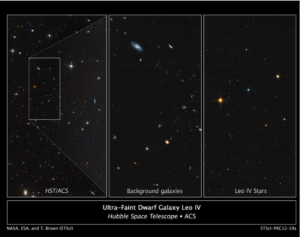Ultra-faint dwarf galaxies could be the key to looking into the past to the early universe and finding the first generation of stars formed after the Big Bang.
These galaxies are unique by being super faint and small. Some calling them fossils! The faintness is due to the fact that they have used up all their star-making materials, like dust and gas, which are responsible for causing the glow in space that we associate with galaxies. They are also very small. Dr. Rodriguez Wimberly compared their sizes to the size of earth in relation to the sun (the Earth being an ultra-faint dwarf galaxy and the sun being the medium-sized Milky Way Galaxy). The most important characteristic is that they were the first galaxies to form, making them a fossil for the early universe.

Dr. Katy Rodriguez Wimberly uses the concept of near field cosmology to learn about the universe. She describes the field as “looking at today to see the past.” Her work with ultra faint dwarf galaxies is an example of near field cosmology. Her goal is to prove that these galaxies could be what are known as ‘True Relics of the Universe’.
To be a True Relic, there are 3 things they must be.
The first thing is to have the stellar classification of a galaxy. Ultra faint dwarf galaxies pass this category, as implied by the name, because they are galaxies! The second category is to have no evolution since the early universe. This is important as it is needed for the stars in the galaxy to be from before the re-ionization period so that they can be classified as “ancient” stars. The ultra faint dwarf galaxies pass this condition; this has been proven through Dr. Rodriguez Wimberly’s research. The third condition is that they must have had a relatively lonely path throughout history. This is still being proven by Dr. Rodriguez Wimberly.
Dr. Rodriguez Wimberly is researching the third condition and is trying to prove this through chemical abundances in the ultra-faint dwarf galaxies. The chemical abundance is a way to look at their evolutionary history.
To find out more about where Dr. Katy Rodriguez Wimberly’s research is going and the impacts it has, visit her website at:
M. Katy Rodriguez Wimblerly Website
To watch the recording of her First Friday presentation visit: